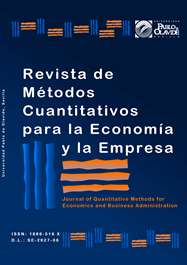Desempeño del número de empleos en tiempos de COVID-19 en dos estados mexicanos con distinta vocación económica
DOI:
https://doi.org/10.46661/revmetodoscuanteconempresa.5217Palabras clave:
trabajo formal, desempeño laboral, COVID-19Resumen
El objetivo de este artículo es medir el desempeño del trabajo formal en dos estados de México con vocación económica distinta: Quintana Roo cuya actividad principal es el turismo y Aguascalientes con actividad principalmente industrial. El trabajo se inicia presentando el contexto laboral en ambos estados y posteriormente se describe la revisión de la literatura relacionada al desempeño de los trabajos formales en México y Latinoamérica. Con los datos oficiales de los trabajadores afiliados al IMSS de 1998 a 2019 se identifica el mejor ajuste; con los parámetros estadísticos obtenidos se analiza el comportamiento mensual del primer cuatrimestre del año 2020 con metodología clásica contrastada con metaanálisis. Los resultados permiten concluir que en periodos previos y durante el distanciamiento social, el número de afiliados al IMSS no solo se mantuvo en niveles convencionales, sino que en varios meses se incrementaron los trabajadores inscritos.
Descargas
Citas
Aguilar, J. (2020). Resonancias. Instituto de Investigaciones Sociales de la UNAM. Desacargado de https://www.iis.unam.mx/blog/mexico-efectos-del-covid-19-en-el-mercado-del-trabajo/
Banco Mundial (2020). Empleo y desarrollo. Descargado de https://www.bancomundial.org/es/topic/jobsanddevelopment/overview
Cumming, G. (2013). Cohen's d needs to be readily interpretable: Comment on shieh. Behavior Research Methods, 45(4), 968-971.
De Jesús, L. & Murillo, B. (2020). Efectos del Covid-19 en el empleo sectorial en México 2020. Economía Actual, 3, 23-29.
Dey, A.K. & Kundu, D. (2009). Discriminating between the log-normal and log-logistic distributions. Communications in Statistics - Theory and Methods, 39(2), 280-292.
Gobierno de Quintana Roo (2020). Estrategia Reactivemos Quintana Roo dentro del plan Juntos Saldremos Adelante. Descargado de https://qroo.gob.mx/portal/estrategia-reactivemos-quintana-roo-dentro-del-plan-juntos-saldremos-adelante-conozcamos-en-que-consiste-y-como-funcionara/
Grace, A.W. & Wood, I.A. (2012). Approximating the tail of the Anderson–Darling distribution. Computational Statistics and Data Analysis, 56(12), 4301-4311.
IMSS (2020). Trabajadores Asegurados - Series de Tiempo TABLEAU. Descargado de https://public.tableau.com/profile/imss.cpe#!/vizhome/Histrico_4/Empleo_h?publish=yes
INEGI (2020). Ocupación - Población de 15 años y más según condición de actividad y disponibilidad, nacional trimestral. Descargado de https://www.inegi.org.mx/temas/empleo/default.html#Tabulados
Negrete, R. (2011). El indicador de la polémica recurrente: la tasa de desocupación y el mercado laboral en México. Revista Internacional de Estadística y Geografía, 2(1), 22-43.
OCDE (2020). Dirección de empleo, asuntos sociales y laborales. Descargado de https://mailchi.mp/oecd/imo-2018
Organización Internacional del Trabajo (2020). Panorama laboral en tiempos del COVID, México: OITAmericas.
Patiño, M. & Cruz, G. (2020). Las medidas adoptadas por las entidades federativas ante la emergencia del Covid-19. Cuaderno de Investigación, 7, 1-162.
Presidencia de la República, 2020. DECRETO por el que se establecen las medidas de austeridad que deberán observar las dependencias y entidades de la Administración Pública Federal bajo los criterios que en el mismo se indican. México: Secretaría de Gobernación.
Rivero, E. (2020). Medidas para la recuperación económica ante la emergencia sanitaria Covid-19: Del crédito solidario al seguro de desempleo. Cuaderno de Investigación, 9, 1-57.
Shin, H., Jung, Y., Jeong, C., & Heo, J. (2012). Assessment of modified Anderson–Darling test statistics for the generalized extreme value and generalized logistic distributions. Stochastic Environmental Research and Risk Assessment, 26(1), 105-114.
Publicado
Cómo citar
Número
Sección
Licencia

Esta obra está bajo una licencia internacional Creative Commons Atribución-CompartirIgual 4.0.
El envío de un manuscrito a la Revista supone que el trabajo no ha sido publicado anteriormente (excepto en la forma de un abstract o como parte de una tesis), que no está bajo consideración para su publicación en ninguna otra revista o editorial y que, en caso de aceptación, los autores están conforme con la transferencia automática del copyright a la Revista para su publicación y difusión. Los autores retendrán los derechos de autor para usar y compartir su artículo con un uso personal, institucional o con fines docentes; igualmente retiene los derechos de patente, de marca registrada (en caso de que sean aplicables) o derechos morales de autor (incluyendo los datos de investigación).
Los artículos publicados en la Revista están sujetos a la licencia Creative Commons CC-BY-SA de tipo Reconocimiento-CompartirIgual. Se permite el uso comercial de la obra, reconociendo su autoría, y de las posibles obras derivadas, la distribución de las cuales se debe hacer con una licencia igual a la que regula la obra original.
Hasta el volumen 21 se ha estado empleando la versión de licencia CC-BY-SA 3.0 ES y se ha comenzado a usar la versión CC-BY-SA 4.0 desde el volumen 22.










